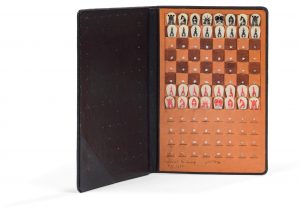Artist to Know: Mona Hatoum
Sotheby’s Greets International Women’s Day With Minimalist Chair Sculpture
Mona Hatoum’s art often holds a web of contradictions. Her early performance work carried distinct political undertones designed to challenge her audience. Gradually, though, the Palestinian artist moved into abstraction. Hatoum invites the viewer to ask critical questions. “I’m working with feelings of displacement, disorientation, estrangement — when the familiar turns into something foreign or even threatening,” she told Emma Robertson of The Talks in an interview. “It’s about shattering the familiar to create uncertainty and make you question things that you normally take for granted.”
A pair of mesh wire chairs from Mona Hatoum will come to auction in Sotheby’s Thinking in Four Dimensions: Leading Women Sculptures sale. Bidding will begin on March 8th and close on March 16th, 2021. Learn more about Hatoum before placing a bid.

The daughter of Palestinian exiles, Mona Hatoum was born and raised in Beirut, Lebanon. Hatoum’s parents maintained their Palestinian identity and culture after they were denied Lebanese identity cards. As a result, the artist often associates feelings of displacement and loss with her childhood. Hatoum was in her early 20s when the Lebanese Civil War broke out in 1975. She was finishing a short trip to London when the news broke. Stranded abroad, Hatoum could not return home for years. Hatoum used the time to earn art degrees from the Byam Shaw School of Art and the Slade School of Fine Art.
During her early career, Hatoum started to process her life experiences through performance art. These performances often explored political themes using Hatoum’s body. In Under Seige, for example, she covered her body in clay and confined herself to a closed container. Revolutionary songs played for observers outside of her self-made prison. Hatoum designed these performances to raise awareness about the increasingly unstable situation in Palestine. The performances were simple and sparse, partly out of financial necessity.
Hatoum gradually shifted away from such projects to explore other mediums. “Traditionally, artists work with certain materials and spend their lives perfecting their skills,” Hatoum told Qantara.de in 2007. “But when you work with ideas, what matters above all is the goal… the effect you want to create, the phenomenology of the space dictates the materials you have to work with.”

Minimalism is a constant in Hatoum’s work. She often strips everyday objects of their context and distorts their proportions to explore new ideas. Two untitled chair sculptures from 1992, presented by Sotheby’s this March, demonstrate these themes. The chairs appear normal at first glance. However, a closer inspection reveals the diminutive height of the smaller chair and subtle slants in the larger chair’s legs. The chairs come from an edition of three with an estimate of USD 30,000 to $50,000.
Hatoum has long grown past the financial difficulties of her college years, experiencing great success as a sculptor and installation artist. In 2019, Hatoum received a GBP 110,000 (USD 153,500) Praemium Imperiale award from the Japan Art Association. Previous winners include David Hockney and Sir Anish Kapoor. Hatoum’s fame has steadily risen in Britain and abroad, particularly after the 1990s.
At auction, Hatoum’s work is regularly listed alongside other major women sculptors of the 20th century. Her glass Silence sculpture achieved $470,500 at Christie’s in 2011, nearly quadrupling its high estimate. It depicts a child’s crib made unstable with pieces of delicate glass tubing. While this sculpture still holds Hatoum’s auction record, recent sales show the artist’s modest but steady success. Phillips sold an untitled wheelchair sculpture by Hatoum for GBP 149,000 (USD 207,900) in 2017. Her 2004 wine bottle installation, designed to imply drowning, achieved EUR 55,000 (USD 66,350) at an Italian auction house the same year. However, those interested in Hatoum’s work will find it more easily in a museum than in the private market.

Hatoum rarely gives out interpretations of her work beyond formal gallery commentary. Instead, she allows the viewer to bring their own experiences and identities to her art. By leaning into abstraction and ambiguity, Hatoum shifts the focus away from her own labels. That philosophy has served her well over the last 40 years. Speaking with The Guardian in 2016, she described her future: “I don’t really understand what ambition means. I take things one piece at a time. I’m excited about working on something, that’s all.”
Mona Hatoum’s untitled chair sculptures will come to auction with Sotheby’s this March. Bidding will start on International Women’s Day, March 8th, and run through March 16th, 2021. Visit Sotheby’s for more information and to place a bid.
Want to know more about modern and contemporary artists? Check out Auction Daily’s coverage of American-Mexican artist Elizabeth Catlett.










